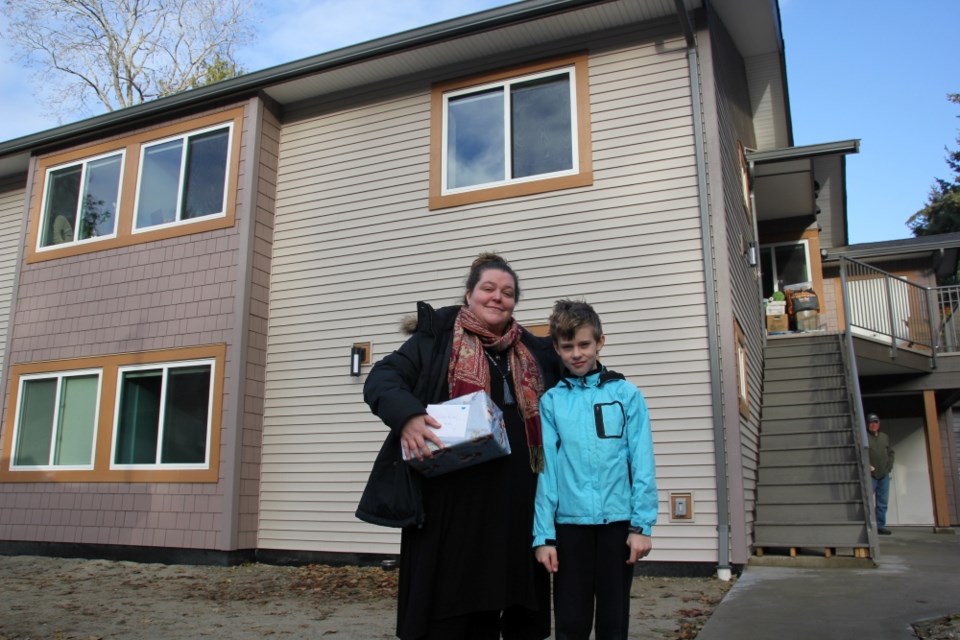As neighbours gathered to welcome three new families into the fold, Habitat for Humanity invited attendees in from the cold.
On Dec. 3, Habitat for Humanity Sunshine Coast hosted a celebration inside its newest unit in ts'uḵw'um (Wilson Creek). The fourplex was built between May and November this year, and its inhabitants have already begun to move in.
Alicia Brooks, one of the new residents, told Coast Reporter moving into the village with her son is “life changing.
“I’m super grateful. It’s a safe place for my son and I,” she said. As a single mom, Brooks is happy her son will have other kids around to play with — without even having to cross a street. The neighbourhood has been very welcoming. “It’s overwhelming.”
The Rotary Club gave each new family a wrapped housewarming gift.
The two-acre site was purchased in 2009. Since then, Habitat for Humanity Sunshine Coast has built six duplexes and the new fourplex. The village is home to 16 families.
Board chair Dave Taylor thanked all who lent a helping hand over the years, from dedicated staff and volunteers to donors and the families themselves. Each Habitat for Humanity family has volunteered up to 500 hours for the project, which Sechelt Mayor John Henderson referred to as not just building a house, but making a home.
“We are delighted to celebrate the completion of this unique modular fourplex, the first of its kind we have undertaken," Taylor said in a press release. "The homes in this building are truly a gift of support from the Sunshine Coast community to our own low-income working families who just need a hand up, not a handout."
At the ceremony, Taylor commented on the expensive building market and how contributions from the Canadian Mortgage and Housing Corporation (CMHC) and BC Housing (around 40 per cent of construction costs) and a generous donor helped.
“If any of you feel so inclined, don’t hesitate to think of Habitat at some point in the future,” Taylor added.
Room for more
There is one unit in the Habitat for Humanity Sunshine Coast building that remains empty: the wheelchair accessible unit. The design meets all of CMHC’s 100-plus accessibility requirements. (The fourplex was also built with a thermal design by BC Passive House in Pemberton, making it more affordable in the long term. “These are quality homes where we have 10-inch walls,” Taylor said.)
Douglas Dunn, the executive director of Habitat for Humanity Sunshine Coast, said he will ask the board on Dec. 5 whether they can reopen the family selection committee to a family that does not require accessibility accommodations. “It’s not that an able-bodied family couldn’t use it,” he said, but that CMHC and Habitat for Humanity are trying to build 20 per cent of all their units to be accessible.
But the cost of living on the Coast can be prohibitive, and the local Habitat has not had a single eligible application for the accessible unit.
“We've sort of discovered that a low-income working family that has accessibility needs, doesn't find the Coast a hospitable place in terms of rent and cost of living,” Dunn said.
At the Dec. 3 event, he put out the “last call” for a family that has at least one member with accessibility needs that qualifies for a Habitat home. Eligible families must already be Sunshine Coast residents, and work with an annual income of between $30,000 and $60,000 per year.
Next steps
While the search continues for the final family, the Habitat crew would like to complete the grading and landscaping of the village. Dunn said they’d like to put down a more drought-resistant ground cover and remove the construction fencing in favour of a more permanent option. Instead of a playground as initially planned, residents have asked to create a gathering area where they can meet as a community and children can play.
Dunn said they would like to have the outdoor work done by next summer, but that will depend on securing a landscaping contractor. The CMHC and BC Housing grants helped cover the cost of building, but Habitat for Humanity still needs to raise funds for completing the grounds.
Looking forward, Habitat is discussing partnering with Cover the Coast and the Affordable Housing Society to move ahead with collaborative projects with the support of local governments and First Nations. Buying land and building, like Habitat did for their recently completed project, is unlikely going to be an affordable option for the non-profit again. The cost of building the fourplex was twice what one of the older units cost, Dunn said.
Once the work is finalized, Habitat will host another celebration, open to the public.
How to help
Dunn said donating to or buying from the Restore in Sechelt helps. (The newest complex was outfitted with handles and fittings all sourced through the Restore.) Donations can always be made directly to www.habitatsc.ca.
One donor mentioned during the celebration was a man who left a donation towards construction costs in his will. This is a good option, Dunn said, for people who are reviewing their estates and find they have more than they anticipated: leaving Habitat in the will.



